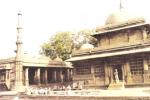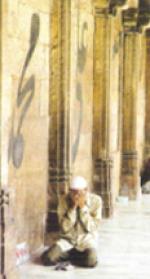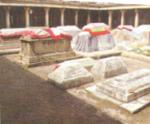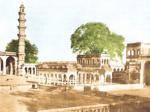As we enter the Tran Darwaza, to the right is the huge Jama Masjid. This mosque, built in 1423 AD, is considered one of the biggest mosques ofIndia. From the artistic and architectural point of view also it is an imposing structure. At one time it occupied. a center of a va~t ground, and was placed at the center of crossing of four roads. If we imagine the present crowding bazaar removed, we can understand its artistic architecture. There were two tall 'Minaras' or minarettes around its main arch that were destroyed due to earthquake. In 1618 AD Mughal Emperor Jahangir visited this mosque. Built with a large number of arches that surround a vast seating area for prayers, it is a beautiful and grand building.
It is 130 m. long and 82 m. wide Of its three gates, one leads to Manek Chowk, the other to Pankor Naka and third opens into Kagdi Pol. The srructure is made from sandstone, though at the place to offer 'namaz' marble has been used. On all sides are pinnacles and windows with eaves Some of these are closed later on with bricks. The ceiling rests on 190 pillars. A mezzanine floor with carved walls is accessible on one side. The central pillars are taller than the rest, and a dome is constructed above to let in the sunrays to light up the area. In the center is a small pond too. In the northern part is an open area with single sloped roof where the sacred words of the Koran are written in bold calligraphy.
This incomparable and grand structure is shadowed in the dirty shops that crowd and ugly constructions around it. From Jame Masjid we can enter another structure called Badshah no Hajiro. Across the road to it is the Rani no Hajiro. Ahmed Shah had built these Rozas for burial after his death, and both are very beautiful. The buildings of Manek Chowk are also interesting. It must have been the center of trading activities even in those days. With the increase in commerce these buildings also went on expanding, and Manek Chowk must have has considerably open space to allow this growth for a long time. Now it is the main center of these activities and is the most crowded area in Ahmedabad. The city of Ahmedabad is based on similar design of Patan where the residences were made into 'Pols', and these went on increasing with the population.
There are some other mosques besides Jama Masjid in Ahmedabad that are notable for their artistic value. The main ones are Zakaria Masjid on Relief Road, Qutubuddin Shah Masjid in Delhi Chakla, the Masjid of Sarangpur, of Rani Rupmati's in Khanpur and of Rani Si[pri in Astodia Darwaza, of Mahafiz Khan in Ghee Kanta area and of Sidi Sayyed in Lal Darwaza. The stone carvings that cut through the stone to make laced designs on of one wall ofthe last named, called 'Sidi Sayyed ni Jali', are world famous and the stones of this Masjid are preserved in museums of some foreign countries too. The replica of one particular leafy-laced carving in silver plate has become a popular brand design for the city in fact. Besides these the Azam Khan no Rojo and the Dariya Khan's Ghummat or the tall dome in Shahibaug are also worth looking at as important Muslim artistic sites.
ROZA OF SHAH ALAM
Shah Alam was a famous saint of Ahmedabad. His residence was known as Rasulabad. Tajkhan Narpali built his Roza after his death in 1475 AD. It has very beautiful net or lace work in stone. It was so admired that if a silk cloth showed their designs called 'Shalmi Bhaat', they would fetch very high price, Opposite this is another similar Roza where his sons rest after death.









